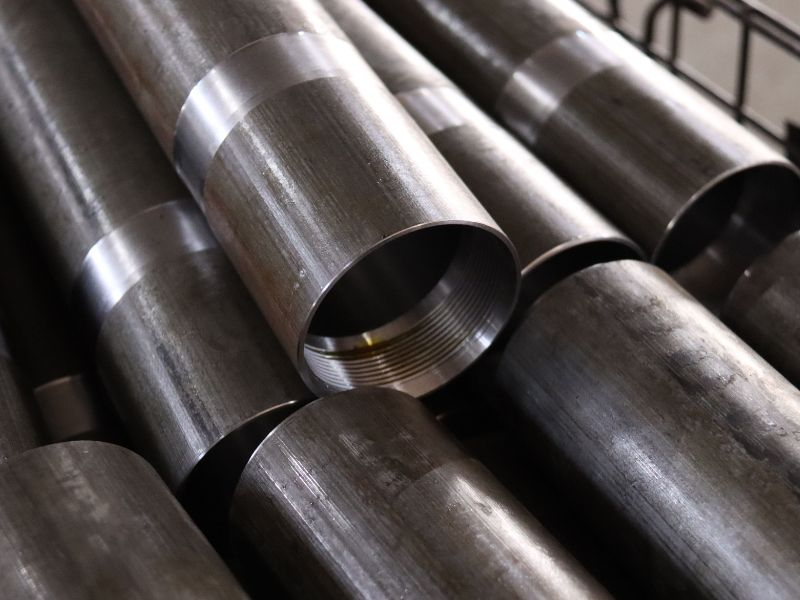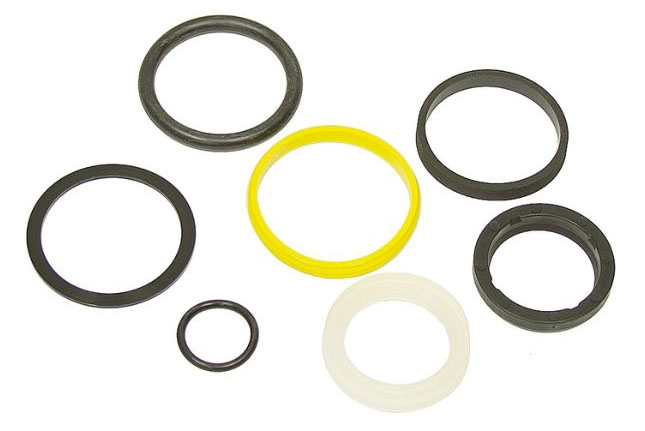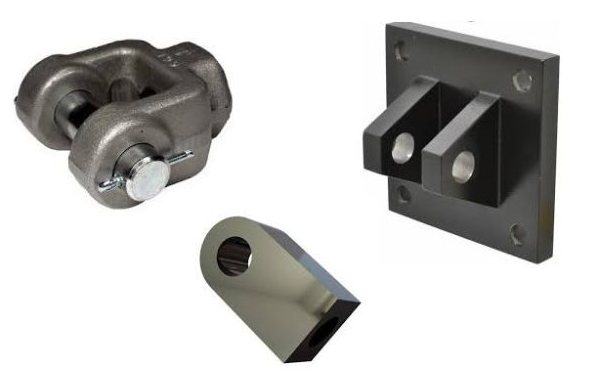Hydraulic cylinders are everywhere, from heavy-duty robotic arms in excavators to precision control systems in aerospace applications. But have you ever wondered what lies beneath the rugged exterior of these hydraulic powerhouses? What materials are tasked with holding and managing high-pressure fluids while ensuring consistent performance and reliability? This article will delve into the heart of hydraulic cylinders and reveal the materials that make up these industrial marvels.
Hydraulic cylinders, the driving force behind a multitude of mechanical systems, are made up of several key components. Each part is crafted from materials carefully selected for their unique properties and contributions to the cylinder's overall functionality.
The cylinder barrel is the backbone of the hydraulic cylinder, a critical component that not only forms the main body but also houses the piston and hydraulic fluid. The choice of material for this part is crucial for ensuring the entire assembly operates effectively under various conditions.

1.High-Grade Carbon Steel
Carbon steel is a popular choice for cylinder barrels due to its impressive strength and durability. This material can handle high pressure and stress, making it ideal for heavy-duty applications such as construction machinery, manufacturing equipment, and agricultural machinery. Its high tensile strength ensures that the barrel can withstand the mechanical forces and pressures exerted during the hydraulic cylinder’s operation without deforming or failing.
Carbon steel barrels are especially valued in applications where the cylinder is subjected to high loads or impacts. For example, in earth-moving equipment, these barrels can endure the rigorous stress of digging, lifting, and moving heavy materials. In manufacturing settings, they provide the necessary robustness for pressing, lifting, or assembling heavy components.
2.Stainless Steel
Stainless steel stands out for its exceptional corrosion resistance, a vital attribute in harsh working environments. This material is especially beneficial for hydraulic cylinders used in maritime applications, chemical processing plants, or any setting where the equipment is exposed to corrosive substances, moisture, or extreme weather conditions.
The corrosion-resistant nature of stainless steel extends the life of the hydraulic cylinder by preventing rust and other forms of corrosion that can weaken the barrel and cause leaks. This feature is crucial for maintaining the integrity and safety of the hydraulic system. For instance, in the marine industry, stainless steel barrels are used in equipment like cranes and hoists, ensuring reliability and safety in the corrosive sea-air environment.
3.Combining Strength and Corrosion Resistance
In some applications, manufacturers may choose to combine the strengths of both materials. For example, a carbon steel barrel might be coated with a layer of stainless steel or another protective coating to enhance its corrosion resistance while maintaining its inherent strength and durability.
Pistons, the core of the hydraulic cylinder, are typically made from robust materials such as steel and aluminum. The choice between these materials depends on the specific requirements of the application.
1.Steel Pistons:
Known for their high strength and resistance to deformation, steel pistons are commonly used in high-pressure environments. They excel in industrial applications where cylinders are subjected to heavy loads and continuous operation. Their ability to resist warping or bending under extreme pressure makes them a standard choice in the industry.
2.Aluminum Pistons:
Aluminum is favored for its lightweight nature and decent strength, making it suitable for applications where weight is a critical factor, such as in aerospace or mobile hydraulic systems. While not as strong as steel, aluminum pistons offer sufficient resistance to deformation in moderate-pressure environments and benefit from a natural resistance to corrosion.
1.Protective Coatings:
To enhance the performance and longevity of rods, they are often coated with materials like chrome or nickel. Chrome plating is widely used for its dual benefits of increasing surface hardness and providing corrosion resistance. This coating is especially important in environments where the rod is exposed to harsh conditions, such as outdoor construction sites or maritime applications. On the other hand, nickel coatings offer superior protection in highly corrosive environments, such as chemical processing plants.

1.Polyurethane:
Widely used due to its excellent wear resistance and durability, polyurethane seals are suitable for a variety of hydraulic applications. They perform well in both high-pressure environments and under conditions with temperature fluctuations. This material is particularly favored for its long service life and resistance to abrasion, making it a cost-effective choice for many industrial applications.
2.Nitrile Rubber (Buna-N):
Nitrile rubber seals are valued for their compatibility with a broad range of hydraulic fluids, including petroleum-based oils. They offer good resistance to oil and fuel, making them ideal for applications in automotive hydraulics and machinery that operates in oil-rich environments. However, they are less suited for high-temperature applications compared to polyurethane and fluorocarbon.
3.Fluorocarbon (Viton):
Fluorocarbon seals stand out for their exceptional resistance to high temperatures and chemicals. They are the preferred choice in applications involving corrosive fluids or in environments where temperatures can reach extremes. Although more expensive, their resistance to degradation in harsh conditions justifies the cost in many high-stakes industrial settings.
1.Chrome Plating for Rods:
Chrome plating is a common choice for hydraulic cylinder rods. It significantly increases the surface hardness of the rod, enhancing its wear resistance. Additionally, chrome plating provides a level of corrosion resistance, which is crucial for cylinders exposed to moisture or corrosive substances. The smooth, hard surface of the chrome plating also reduces friction, which benefits the longevity of the seals by minimizing wear.
2.Paint or Powder Coatings for Cylinder Exteriors:
To protect the external surface of the cylinder barrel and other components, various paint or powder coatings are applied. These coatings are designed to resist corrosion, UV radiation, and chemical exposure, thereby extending the lifespan of the cylinder. The type of coating chosen depends on the environmental conditions the cylinder will face, with options ranging from simple acrylic paints for minimal exposure to more robust epoxy or polyurethane coatings for severe conditions.

1.Steel Mounts:
The most commonly used material for hydraulic cylinder mounts is steel, known for its strength, durability, and ability to withstand heavy loads. Steel mounts are ideal for applications where the cylinder is subjected to high stress and load-bearing requirements. These mounts maintain their integrity under challenging conditions, such as in construction equipment, heavy machinery, and industrial applications. The robust nature of steel ensures that the mounts can securely anchor the cylinder, providing a stable and reliable base for operation.
2.Aluminum Mounts:
In applications where weight is a significant consideration, aluminum mounts offer a beneficial alternative. Being lighter than steel, aluminum is preferred in mobile applications, such as in automotive or aerospace hydraulics. Its natural resistance to corrosion also makes it suitable for environments prone to moisture or chemical exposure. While not as strong as steel, aluminum mounts provide adequate support for moderate-load applications and have the advantage of being easier to handle and install due to their lighter weight.
Hydraulic Fluid: Hydraulic fluid is the lifeblood of any hydraulic system, and its role in the operation of hydraulic cylinders is crucial. It serves as the medium for power transmission, and the type of hydraulic fluid used is essential for the system’s efficiency, reliability, and longevity.
1.Mineral Oils:
These are the most commonly used hydraulic fluids. Derived from refining crude oil, mineral oils are valued for their excellent lubrication properties and stability across a wide range of operating temperatures. They are typically used in general industrial and mobile hydraulic systems.
2.Water-Glycol Solutions:
Water-glycol fluids are used in applications that require fire resistance. These solutions consist of a mixture of water and glycol, which significantly reduces the risk of combustion in high-temperature environments or near ignition sources. However, they have lower lubrication properties compared to mineral oils and may require more frequent maintenance.
3.Synthetic Fluids:
Synthetic hydraulic fluids are engineered for specific properties such as fire resistance, biodegradability, or extreme temperature operation. These fluids are often used in specialized applications where environmental concerns or extreme operating conditions are present. Examples include phosphate esters for fire resistance and organophosphate esters for environmentally sensitive applications.
Research on materials used in hydraulic cylinders has revealed a complex interplay between engineering requirements, operational needs, and economic factors. From the robust carbon steel or stainless steel used in hydraulic cylinder barrels to the innovative composite materials found in emerging designs, each material is chosen for its unique properties and suitability for specific applications. If you have any further questions about material selection for hydraulic cylinders, feel free to ask HCIC!